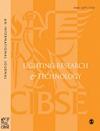神经网络模型估算LED光谱功率分布的比较与验证
IF 2.2
3区 工程技术
Q2 CONSTRUCTION & BUILDING TECHNOLOGY
引用次数: 0
摘要
光谱功率分布(SPD)是光源的真实指纹,主要取决于电和热负载。光度和比色量最初都是从SPD中提取的。因此,对LED的SPD进行动态预测已成为评价LED在工作期间性能的一个重要方面。一般采用统计模型来预测SPD。但是,多输入的统计模型使得系统复杂且耗时。另一方面,人工神经网络(ANN)模型可以帮助解决这个问题。本研究的主要目标是提高人工神经网络在照明应用中的效用。各种神经网络(NN)结构,即模型1、2和3,结合各种神经元和隐藏层(HLs)来预测零时各种电和热应力水平的SPD,证明了这一点。将结果进行比较,在绝对预测误差(APE)设为5%的基础上,认为模型1是SPD预测的最佳模型。此外,利用温度、波长和时间作为LED灯具的输入参数,对模型1基于时间的SPD预测进行了研究,并进行了验证。本文章由计算机程序翻译,如有差异,请以英文原文为准。
Comparison and validation of neural network models to estimate LED spectral power distribution
The spectral power distribution (SPD) is the true fingerprint of a light source and is mainly dependent on electrical and thermal loading. Both the photometric and colorimetric quantities are originally extracted from SPD. Therefore, the dynamic prediction of SPD for LED has become an important aspect to evaluate the performance of LED during its time of operation. Generally, the statistical models are used to predict SPD. However, the statistical model with more than two input makes the system complex and time demanding. Artificial Neural Network (ANN) models, on the other hand, can help with this problem. The major goal of this research is to improve the utility of ANN in lighting applications. This is demonstrated by various neural network (NN) structures referred as models 1, 2 and 3 with combinations of varied neurons and hidden layers (HLs) to forecast SPD for various electrical and thermal stress levels at zero hours. The results are compared and based on absolute prediction error (APE) set to 5%, model 1 is considered as the best model for the SPD prediction. In addition, the time-based SPD prediction with model 1 is investigated using temperature, wavelength and time as input parameters for the LED luminaire and is validated.
求助全文
通过发布文献求助,成功后即可免费获取论文全文。
去求助
来源期刊

Lighting Research & Technology
工程技术-光学
CiteScore
5.40
自引率
16.00%
发文量
69
审稿时长
>12 weeks
期刊介绍:
Lighting Research & Technology (LR&T) publishes original peer-reviewed research on all aspects of light and lighting and is published in association with The Society of Light and Lighting. LR&T covers the human response to light, the science of light generation, light control and measurement plus lighting design for both interior and exterior environments, as well as daylighting, energy efficiency and sustainability
 求助内容:
求助内容: 应助结果提醒方式:
应助结果提醒方式:


